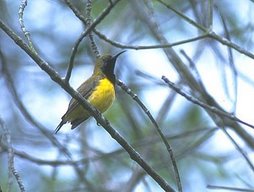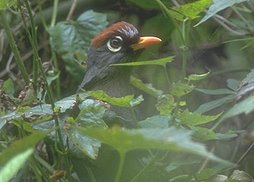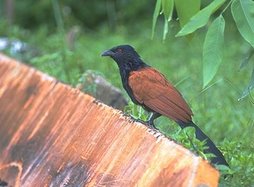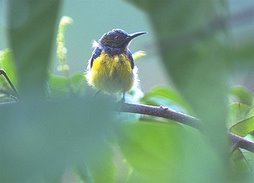Malaysia is located in the near equator. The climate is humid throughout the year. Tall trees grow more than 50 meter from the ground and wide variety of trees forms dense and dark tropical forest, "jungle". Thousands species of wildlife inhabit inside of the jungle. Gibbons, Tiger, Asian Elephant, Sun Bear...etc. The forest is so rich to sustain the large mammals.In the peninsular Malaysia, about 650 spp. of birds have been recorded. It includes, long-tailed pheasant: Great Argus, Hornbills, , which have huge bills and Pittas like jewels in the jungle.In this page, I'm introducing you some of the interesting and wonderful birds in Malaysia
Red-headed Trogon male © Koji TAGIRed-headed Trogon is a dweller of montane forest in Malaysia. It is surprisingly difficult to focus in the forest in spite of the vivid color.
Jungle Birds in Malaysia
If you would like to go birdwatching in lowland jungle forest in Malaysia, you need to be
 /have:
/have:-an early bird, even doesn't mind to arrive at a
birding spot by 7:00 a.m.
-very sensitive ear which enable to identify
bird's call/noise
-patience to wait for shy or secretive bird
tough neck to see birds on the top of the 50 meter height trees.
Birdwatching in the lowland jungle is so challenging but is doubtlessly exciting.
Generally, birds in lowland jungle are active during early in the morning. It is not so difficult to see over 40 species in one place within a few hours if you go birding in the timing. For example, Scarlet Minivet (photo) is commonly seen in the early morning. Additionally, temperature is relatively low in the morning. So, you do not need to worry so much heating while the birding.
In the jungle, likely bulbuls and leafbirds, several species of birds form a mixed flock. The mixed flock is called "bird wave" while the birds appear and disappear as move of waves. The bird wave consists of often more than ten and sometimes more than fifteen species of birds. @
Whenever you encounter a bird wave, you should firstly keep observing birds as many as possible. You can check your field g uide later but the birds disappear into the forest within ten minutes. At the canopy, you may see long-tailed birds are moving. They are mostly minivets, such as Fiery and Scarlet Minivets or Bar-winged and Black-winged Flycatcher-shrike. Bulbuls, likely Red-eyed, Olive-winged, Grey-bellied and Buff-vented, and leafbird, such as Blue-winged and Lesser Green, can be seen in the middle storey with a small flock. A chunky green bird may fly from a tall tree to another tree. Gold-whiskered Barbet is impressive with yellow patch on the face.
uide later but the birds disappear into the forest within ten minutes. At the canopy, you may see long-tailed birds are moving. They are mostly minivets, such as Fiery and Scarlet Minivets or Bar-winged and Black-winged Flycatcher-shrike. Bulbuls, likely Red-eyed, Olive-winged, Grey-bellied and Buff-vented, and leafbird, such as Blue-winged and Lesser Green, can be seen in the middle storey with a small flock. A chunky green bird may fly from a tall tree to another tree. Gold-whiskered Barbet is impressive with yellow patch on the face.
Generally, birds in lowland jungle are active during early in the morning. It is not so difficult to see over 40 species in one place within a few hours if you go birding in the timing. For example, Scarlet Minivet (photo) is commonly seen in the early morning. Additionally, temperature is relatively low in the morning. So, you do not need to worry so much heating while the birding.
In the jungle, likely bulbuls and leafbirds, several species of birds form a mixed flock. The mixed flock is called "bird wave" while the birds appear and disappear as move of waves. The bird wave consists of often more than ten and sometimes more than fifteen species of birds. @
Whenever you encounter a bird wave, you should firstly keep observing birds as many as possible. You can check your field g
 uide later but the birds disappear into the forest within ten minutes. At the canopy, you may see long-tailed birds are moving. They are mostly minivets, such as Fiery and Scarlet Minivets or Bar-winged and Black-winged Flycatcher-shrike. Bulbuls, likely Red-eyed, Olive-winged, Grey-bellied and Buff-vented, and leafbird, such as Blue-winged and Lesser Green, can be seen in the middle storey with a small flock. A chunky green bird may fly from a tall tree to another tree. Gold-whiskered Barbet is impressive with yellow patch on the face.
uide later but the birds disappear into the forest within ten minutes. At the canopy, you may see long-tailed birds are moving. They are mostly minivets, such as Fiery and Scarlet Minivets or Bar-winged and Black-winged Flycatcher-shrike. Bulbuls, likely Red-eyed, Olive-winged, Grey-bellied and Buff-vented, and leafbird, such as Blue-winged and Lesser Green, can be seen in the middle storey with a small flock. A chunky green bird may fly from a tall tree to another tree. Gold-whiskered Barbet is impressive with yellow patch on the face.A large and long-tailed bird which soars from the canopy is malkohas. Although malkoha genetically close to cuckoos, they make a nest themselves. In the lowland jungle, you can see two common species o f malkohas. A large malkoha with chestnut-breast and shining bronze green upperparts is Chestnut-breasted Malkoha (left). Smaller one with rufous tail and belly is Raffles's Malkoha. Despite the size, malkoha is a shy bird which always stay behind leaves.@
f malkohas. A large malkoha with chestnut-breast and shining bronze green upperparts is Chestnut-breasted Malkoha (left). Smaller one with rufous tail and belly is Raffles's Malkoha. Despite the size, malkoha is a shy bird which always stay behind leaves.@
There are also many cuckoo species in the jungle. Drongo Cuckoo looks very similar to a Black or Bronzed Drongo unless you see the slightly long and decurved bill. Indian Cuckoo is a common forest dweller but is very hard to see while it sits in the middle storey. Both male of Emerald and Violet Cuckoos are very attractive. However, again it is very challenging to find them.@
Among the bird wave, if you find a slow-moving and dumpy bird, it should be a broadbill. Black-and-yellow Broadbill (TOP PAGE) is a small dumpy bird with a large head and bill. The broadbill has a similar call with Banded Broadbill which is entirely vinous instead of black head with white collar. However, Banded start calling with sharp "wheeoo" while Black-and-yellow calls gradually faster without the introduction. Although their colour and calls are distinctive, they are usually very quiet in the bird wave.
 f malkohas. A large malkoha with chestnut-breast and shining bronze green upperparts is Chestnut-breasted Malkoha (left). Smaller one with rufous tail and belly is Raffles's Malkoha. Despite the size, malkoha is a shy bird which always stay behind leaves.@
f malkohas. A large malkoha with chestnut-breast and shining bronze green upperparts is Chestnut-breasted Malkoha (left). Smaller one with rufous tail and belly is Raffles's Malkoha. Despite the size, malkoha is a shy bird which always stay behind leaves.@There are also many cuckoo species in the jungle. Drongo Cuckoo looks very similar to a Black or Bronzed Drongo unless you see the slightly long and decurved bill. Indian Cuckoo is a common forest dweller but is very hard to see while it sits in the middle storey. Both male of Emerald and Violet Cuckoos are very attractive. However, again it is very challenging to find them.@
Among the bird wave, if you find a slow-moving and dumpy bird, it should be a broadbill. Black-and-yellow Broadbill (TOP PAGE) is a small dumpy bird with a large head and bill. The broadbill has a similar call with Banded Broadbill which is entirely vinous instead of black head with white collar. However, Banded start calling with sharp "wheeoo" while Black-and-yellow calls gradually faster without the introduction. Although their colour and calls are distinctive, they are usually very quiet in the bird wave.
Bird wave contains even woodpeckers. Unlikely other birds, woodpeckers are easily found because of the posture and perching style. There are more than 20 species of woodpeckers in Malaysia. Grey-and-buff  Woodpecker (photo) is distinctive with the large crest with the short tail. A large crow size Slaty-backed Woodpecker is sometimes seen at the edge of the lowland forest. Banded, Crimson-winged and Checker-throated Woodpeckers are similar each other. All of them have yellow crest and reddish wing. However, it can be identified with the pattern of their faces. @Maroon Woodpecker, which has a harsh call, reminds me an endangered Pryer's Woodpecker of Okinawa, because of the unusual colour. Rufous Piculet is a tiny and dumpy bird with a very short tail. Unlikely the size, the drumming is very loud.
Woodpecker (photo) is distinctive with the large crest with the short tail. A large crow size Slaty-backed Woodpecker is sometimes seen at the edge of the lowland forest. Banded, Crimson-winged and Checker-throated Woodpeckers are similar each other. All of them have yellow crest and reddish wing. However, it can be identified with the pattern of their faces. @Maroon Woodpecker, which has a harsh call, reminds me an endangered Pryer's Woodpecker of Okinawa, because of the unusual colour. Rufous Piculet is a tiny and dumpy bird with a very short tail. Unlikely the size, the drumming is very loud.
 Woodpecker (photo) is distinctive with the large crest with the short tail. A large crow size Slaty-backed Woodpecker is sometimes seen at the edge of the lowland forest. Banded, Crimson-winged and Checker-throated Woodpeckers are similar each other. All of them have yellow crest and reddish wing. However, it can be identified with the pattern of their faces. @Maroon Woodpecker, which has a harsh call, reminds me an endangered Pryer's Woodpecker of Okinawa, because of the unusual colour. Rufous Piculet is a tiny and dumpy bird with a very short tail. Unlikely the size, the drumming is very loud.
Woodpecker (photo) is distinctive with the large crest with the short tail. A large crow size Slaty-backed Woodpecker is sometimes seen at the edge of the lowland forest. Banded, Crimson-winged and Checker-throated Woodpeckers are similar each other. All of them have yellow crest and reddish wing. However, it can be identified with the pattern of their faces. @Maroon Woodpecker, which has a harsh call, reminds me an endangered Pryer's Woodpecker of Okinawa, because of the unusual colour. Rufous Piculet is a tiny and dumpy bird with a very short tail. Unlikely the size, the drumming is very loud.In the forest, you are also able to see birding without encountering with a bird wave. Scarlet-rumped Trogon sits down quietly in the forest. The brilliant red trogon with a black head is easily overlooked when it is perching in the middle or lower storey. Trogons normally show the olive-brown upper parts rather than the red belly. @Rather larger Red-naped or Diard's Trogon are also seen in the same habitat. Forktails inhabit streams in the forest. Chestnut-naped Forktail is relatively common along the stream in the lowland jungle. It wags the tail as wagtails. It is a very shy bird. The long-tailed bird immediately flushes even 20 or 30 meter away from the bird.
Babblers are commonly seen in lower storey or undergrowth. They are normally shy but noisy birds. A common Striped Tit-Babbler's call is very distinctive "chut-chut-chut-chut", though the streaked brownish bird is less seen.
As I mentioned here, there are wide variety of birds in the jungle. I visited Gombak Valley more than 20 times during my stay in Kuala Lumpur for two years. It is normally not easy to see something new if we go a birding spot more than five times. However, I was nearly always able to see something new. It is obviously evidence that the lowland jungle is a habitat for wide variety of birds where the biological diversity is big.








No comments:
Post a Comment